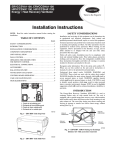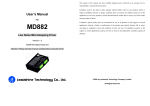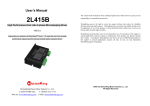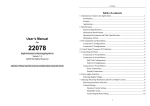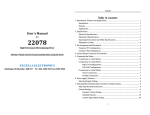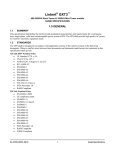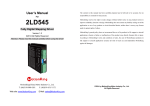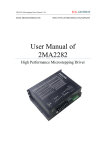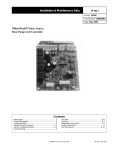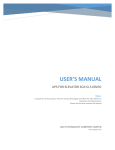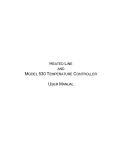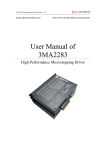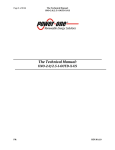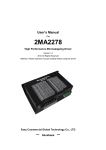Download User`s Manual
Transcript
User’s Manual For 3L1183M High Performance & Low Noise 3-phase Microstepping Driver Version 1.0 ©2009 All Rights Reserved The content in this manual has been carefully prepared and is believed to be accurate, but no responsibility is assumed for inaccuracies. MotionKing reserves the right to make changes without further notice to any products herein to improve reliability, function or design. MotionKing does not assume any liability arising out of the application or use of any product or circuit described herein; neither does it convey any license under its patent rights of others. MotionKing’s general policy does not recommend the use of its products in life support or aircraft applications wherein a failure or malfunction of the product may directly threaten life or injury. According to MotionKing’s terms and conditions of sales, the user of MotionKing’s products in life support or aircraft applications assumes all risks of such use and indemnifies MotionKing against all damages. Attention: Please read this manual carefully before using the driver! MotionKing(China) Motor Industry Co., Ltd. T: (86)519-8988 6261 F: (86)519-8515 1172 Web site: www.MotionKing.com E-Mail: [email protected] ©2009 by MotionKing. All Rights Reserved Contents Table of contents Contents Problem Symptoms and Possible Causes .............................................................. 11 1. Introduction, Features and Applications ...................................................................... 1 Introduction ............................................................................................................. 1 Features ................................................................................................................... 1 Applications............................................................................................................. 1 2. Specifications .............................................................................................................. 1 Electrical Specifications .......................................................................................... 1 Mechanical Specifications....................................................................................... 2 Operating Environment and Other Specifications ................................................... 2 Elimination of Heat ................................................................................................. 2 3. Pin Assignment and Description.................................................................................. 3 Connector P1 Configurations .................................................................................. 3 Connector P2 Configurations .................................................................................. 3 4. Control Signal Connector (P1) Interface ..................................................................... 4 5. Connecting the Motor.................................................................................................. 5 6. Power Supply Selection............................................................................................... 5 Selecting Supply Voltage......................................................................................... 5 7. Selecting Microstep Resolution and Driver Output Current ....................................... 6 Microstep Resolution Selection............................................................................... 6 Current Settings ....................................................................................................... 7 Dynamic Current Setting ................................................................................. 7 Standstill Current............................................................................................. 8 8. Wiring Notes................................................................................................................ 8 9. Typical Connection...................................................................................................... 8 10. Sequence Chart of Control Signals............................................................................ 9 11. Protection Functions ................................................................................................ 10 Over-voltage and Short-voltage Protections.......................................................... 10 Short Circuit Protection ......................................................................................... 10 Wrong Motor Connection Protection .................................................................... 10 Over temperature Protection.................................................................................. 10 12. Frequently Asked Questions.................................................................................... 10 I II 3L1183M Microstepping Driver Manual V1.0 3L1183M Microstepping Driver Manual V1.0 Mechanical Specifications (unit: mm [inch]) 1. Introduction, Features and Applications Introduction The 3L1183M is a high performance and low noise 3-phase microstepping driver based on pure-sinusoidal current control technology. It’s suitable for driving any 3--phase hybrid stepping motors from NEMA 34 to 43. By using advanced bipolar constant-current chopping technique, the 3L1183M can output more torque than other drivers at high speed. The microstep capability allows stepping motors to run at higher smoothness, less vibration and lower noise. Its pure-sinusoidal current control technology allows coil current to be well controlled with relatively small current ripple, therefore smaller motor noise and less motor heating can be achieved. In addition, the 3L1183M has a built-in EMI filter which can make the driver operate with higher reliability. Features z High quality, cost-effective z Low motor noise and heating z Supply voltage up to 220VAC (310VDC) z Output current up to 8.2A(5.86 ARMS) z TTL compatible and Opto-isolated inputs z Automatic idle-current reduction z Input frequency up to 250KHz z 16 microstep resolutions selectable z Over-voltage, short-voltage, over-current and short-circuit protection z DIP switch microstep & current settings z Support PUL/DIR & CW/CCW modes Figure 1: Mechanical specifications Operating Environment and Other Specifications Applications Natural Cooling or Forced cooling Cooling Suitable for large and medium automation machines and equipments, such as engraving machines, labeling machines, cutting machines, laser phototypesetting systems, plotting instruments, NC machines, pick-place devices, and so on. Particularly adapt to the applications desired with low motor noise, low motor heating, high speed and high precision. Environment Operating Environment 2. Specifications Electrical Specifications (25℃/77℉) Ambient Temperature 0℃ - 50℃ (32℉ - 122℉) Humidity 40%RH - 90%RH Operating Temperature 70℃ (158℉) Max Vibration 5.9m/s2 Max -20℃ - 65℃ (-4℉ - 149℉) Storage Temperature Parameters Output current Supply voltage Logic signal current Pulse input frequency Isolation resistance Min 2.0 (1.41A RMS) 90(126) 7 0 500 1 3L1183M Typical Max 8.2(5.86A RMS) 100(140) 150(210) 10 16 200 Unit A VAC(VDC) mA KHz MΩ Web Site: www.MotionKing.com Avoid dust, oil fog and corrosive gases Approx. Weight 1.0 kg (35.25 oz) Elimination of Heat z z Driver’s reliable working temperature should be <70℃(158℉), and motor working temperature should be <80℃(176℉); Forced cooling the driver if it’s necessary. 2 Web Site: www.MotionKing.com 3L1183M Microstepping Driver Manual V1.0 3L1183M Microstepping Driver Manual V1.0 3. Pin Assignment and Description V Motor phase V The 3L1183M has two connectors, connector P1 for control signals connections, and connector P2 for power and motor connections. The following tables are brief descriptions of the two connectors of the 3L1183M. More detailed descriptions of the pins and related issues are presented in section 4, 5, 9. W Motor phase W PUL+(+5V) PUL-(PUL) DIR+(+5V) DIR-(DIR) ENA+(+5V) ENA-(ENA) FAULT+ FAULT- Exchanging the connections of two phases to the driver will reverse motor motion direction. 4. Control Signal Connector (P1) Interface Connector P1 Configurations Pin Function Remark: Please note that motion direction is also related to motor-driver wiring matches. Details Pulse signal: In single pulse (pulse/direction) mode, this input represents pulse signal, effective for each rising edge; 4-5V when PUL-HIGH, 0-0.5V when PUL-LOW. In double pulse mode (pulse/pulse) , this input represents clockwise (CW) pulse,effective for high level. For reliable response, pulse width should be longer than 1.2μs. Series connect resistors for current-limiting when +12V or +24V used. DIR signal: In single-pulse mode, this signal has low/high voltage levels, representing two directions of motor rotation; in double-pulse mode(set by inside jumper), this signal is counter-clock (CCW) pulse, effective for high level. For reliable motion response, DIR signal should be ahead of PUL signal by 5μs at least. 4-5V when DIR-HIGH, 0-0.5V when DIR-LOW. Please note that motion direction is also related to motor-driver wiring match. Exchanging the connection of two wires for a coil to the driver will reverse motion direction. Enable signal: This signal is used for enabling/disabling the driver. High level (NPN control signal, PNP and Differential control signals are on the contrary, namely Low level for enabling.) for enabling the driver and low level for disabling the driver. Usually left UNCONNECTED (ENABLED). Fault signal positive: FAULT+ is an optocoupler output from open-collector circuit, maximum permitted input voltage is 30VDC; maximum output current 20mA. It generally can be serial connected to PLC input terminal. Fault signal negative. The 3L1183M can accept differential and single-ended input signals (including open-collector and PNP output). The 3L1183M has 3 optically isolated logic inputs which are located on connector P1 to accept line driver control signals. These inputs are isolated to minimize or eliminate electrical noises coupled onto the drive control signals. Recommend use line driver control signals to increase noise immunity of the driver in interference environments. In the following figures, connections to open-collector and PNP signals are illustrated. Figure 2: Connections to open-collector signal (common-anode) Connector P2 Configurations Pin Function PE AC AC U Details Ground terminal. Recommend connect this port to the ground for better safety. AC power supply inputs. Recommend use isolation transformers with theoretical output voltage of 150~220 VAC. Motor phase U 3 Web Site: www.MotionKing.com 4 Web Site: www.MotionKing.com 3L1183M Microstepping Driver Manual V1.0 Figure 3: Connection to PNP signal (common-cathode) 5. Connecting the Motor The connection between the driver and 3-phase stepping motors includes two different kinds of connections, namely delta-connection and star-connection. Using delta-connection, the performances of the motor under high speed condition are better, but the driver current is higher too (about 1.73 times the motor coil current); while using star-connection, the driver current equals to the motor coil current. 3L1183M Microstepping Driver Manual V1.0 theoretical output voltage of 150~220VAC or 210~310VDC, leaving room for power fluctuation and back-EMF. If the motion speed requirement is low, it’s better to use lower supply voltage to decrease noise, heating and improve reliability. 7. Selecting Microstep Resolution and Driver Output Current This driver uses a 8-bit DIP switch to set microstep resolution, motor operating current and control signal mode as shown in the following figure: Microstep Resolution Selection Figure 4: Motor connections 6. Power Supply Selection Microstep resolution is set by SW1, 2, 3, 4 of the DIP switch as shown in the following table: Steps/rev.(for 1.8°motor) SW1 SW2 SW3 SW4 200 ON ON ON ON The 3L1183M can match large and medium size stepping motors (from NEMA size 34 to 43) made by MotionKing or other motor manufactures around the world. To achieve good driving performances, it is important to select supply voltage and output current properly. Generally speaking, supply voltage determines the high speed performance of the motor, while output current determines the output torque of the driven motor (particularly at lower speed). 400 OFF ON ON ON 1600 ON OFF ON ON 3200 OFF OFF ON ON 6400 ON ON OFF ON Attention: For safety and to improve reliability, it is recommended to use isolation transformer 12800 OFF ON OFF ON 25600 ON OFF OFF ON 500 OFF OFF OFF ON 1000 ON ON ON OFF 1200 OFF ON ON OFF 2000 ON OFF ON OFF 4000 OFF OFF ON OFF 5000 ON ON OFF OFF 6000 OFF ON OFF OFF 8000 ON OFF OFF OFF instead of directly use network source to supply the 3L1183M. Recommend use isolation transformers with theoretical output voltage of 90~150VAC or 126~210VDC, leaving room for power fluctuation and back-EMF. And the power of the isolation transformer should larger than 500 watts. Selecting Supply Voltage The 3L1183M can actually operate within 90~150VAC or 126~210VDC, including power input fluctuation and back EMF voltage generated by motor coils during motor shaft deceleration. Higher supply voltage can increase motor torque at higher speeds, thus helpful for avoiding losing steps. However, higher voltage may cause bigger motor vibration at lower speed, and it may also cause over-voltage protection or even driver damage. Therefore, it is suggested to choose only sufficiently high supply voltage for intended applications, and it is suggested to use power supplies with 5 Web Site: www.MotionKing.com 6 Web Site: www.MotionKing.com 3L1183M Microstepping Driver Manual V1.0 OFF 10000 OFF OFF OFF Current Settings 3L1183M Microstepping Driver Manual V1.0 Notes: Due to motor inductance, the actual current in the coil may be smaller than the dynamic current setting, particularly under high speed condition. Standstill Current For a given motor, higher driver current will make the motor to output more torque, but at the same time causes more heating in the motor and driver. Therefore, output current is generally set to be such that the motor will not overheat for long time operation. Since parallel and serial connections of motor coils will significantly change resulting inductance and resistance, it is therefore important to set driver output current depending on motor phase current, motor leads and connection methods. Phase current rating supplied by motor manufacturer is important in selecting driver current, however the selection also depends on leads and connections. The latter four bits (SW5, 6, 7, 8) of the DIP switch are used to set the dynamic current. Select a setting closest to your motor’s required current. Dynamic Current Setting Peak current (A) RMS (A) SW5 SW6 SW7 SW8 2.00A 1.41A OFF OFF OFF OFF 2.40A 1.70A OFF OFF OFF ON 2.80A 1.98A OFF OFF ON OFF 3.20A 2.26A OFF OFF ON ON 3.60A 2.55A OFF ON OFF OFF 4.20A 2.97A OFF ON OFF ON 4.80A 3.39A OFF ON ON OFF 5.20A 3.68A OFF ON ON ON 5.60A 3.96A ON OFF OFF OFF 6.00A 4.24A ON OFF OFF ON 6.40A 4.53A ON OFF ON OFF 6.80A 4.81A ON OFF ON ON 7.20A 5.09A ON ON OFF OFF 7.60A 5.37A ON ON OFF ON 8.00A 5.68A ON ON ON OFF 8.20A 5.80A ON ON ON ON 7 Web Site: www.MotionKing.com The 3L1183M has automatic idle-current reduction function. The current automatically be reduced to 60% of the selected dynamic current setting 0.2 second after the last pulse. Theoretically, this will reduce motor heating to 36% (due to P=I2*R) of the original value. If the application needs a different standstill current, please contact MotionKing. 8. Wiring Notes In order to improve anti-interference performance of the driver, it is recommended to use twisted pair shield cable. To prevent noise incurred in pulse/dir signal, pulse/direction signal wires and motor wires should not be tied up together. It is better to separate them by at least 10 cm, otherwise the disturbing signals generated by motor will easily disturb pulse direction signals, causing motor position error, system instability and other failures. If a power supply serves several drivers, separately connecting the drivers is recommended instead of daisy-chaining. It is prohibited to pull and plug connector P2 while the driver is powered ON, because there is high current flowing through motor coils (even when motor is at standstill). Pulling or plugging connector P2 with power on will cause extremely high back-EMF voltage surge, which may damage the driver. 9. Typical Connection A complete stepping system should include stepping motor, stepping driver, power supply and controller (pulse generator). A typical connection is shown as figure 5. 8 Web Site: www.MotionKing.com 3L1183M Microstepping Driver Manual V1.0 3L1183M Microstepping Driver Manual V1.0 connected). See “Connector P1 Configurations” for more information. 3L1183M (2) t2: DIR must be ahead of PUL effective edge by at least 5μs to ensure correct direction; (3) t3: Pulse width not less than 2μs; (4) t4: Low level width not less than 2μs. 11. Protection Functions To improve reliability, the driver incorporates some built-in protection features. Over-voltage and Short-voltage Protections 90~150V When power supply voltage exceeds 280VAC or 395VDC, over-voltage protection will be activated and the RED ALARM LED will light. When power supply voltage is lower than 68VAC or 97VDC, short-voltage protection will be activated and the RED ALARM LED will light. Short Circuit Protection Protection will be activated in case of short circuit between motor coils or between motor coil and ground. Figure 5: Typical connection Wrong Motor Connection Protection 10. Sequence Chart of Control Signals Protection will be activated when the motor is connected in a wrong way. In order to avoid some fault operations and deviations, PUL, DIR and ENA signals should abide by some rules, shown as following diagram: Over temperature Protection Protection will be activated when driver temperature reaches to 85℃. When above protections are active, the motor shaft will be free and the RED ALARM LED will light. Reset the driver by repowering it to make it function properly after removing above problems. 12. Frequently Asked Questions Figure 6: Sequence chart of control signals Remark: (1) t1: ENA must be ahead of DIR by at least 5μs. Usually, ENA+ and ENA- are NC (not 9 Web Site: www.MotionKing.com In the event that your 3L1183M doesn’t operate properly, the first step is to identify whether the problem is electrical or mechanical in nature. The next step is to isolate the system component that is causing the problem. As part of this process you may have to disconnect the individual components that make up your system and verify that they operate independently. It is important to document each step in the troubleshooting process. You may need this documentation to refer back to at a later date, and these details will greatly assist our Technical Support staff in determining the problem should you need assistance. 10 Web Site: www.MotionKing.com 3L1183M Microstepping Driver Manual V1.0 Many of the problems that affect motion control systems can be traced to electrical noise, controller software errors, or mistake in wiring. Problem Symptoms and Possible Causes Symptoms Possible Problems No power Microstep resolution setting is wrong DIP switch current setting is wrong Motor is not rotating Fault condition exists The driver is disabled Motor rotates in the wrong direction Motor phases may be connected in reverse DIP switch current setting is wrong The driver in fault Something wrong with motor coil Control signal is too weak Control signal is interfered Wrong motor connection Erratic motor motion Something wrong with motor coil Current setting is too small, losing steps Current setting is too small Motor is undersized for the application Motor stalls during acceleration Acceleration is set too high Power supply voltage too low Inadequate heat sinking / cooling Automatic current reduction function not being utilized Excessive motor and driver heating Current is set too high 11 Web Site: www.MotionKing.com ND2282 Microstepping Driver Manual V1.0 13 Web Site: www.MotionKing.com









